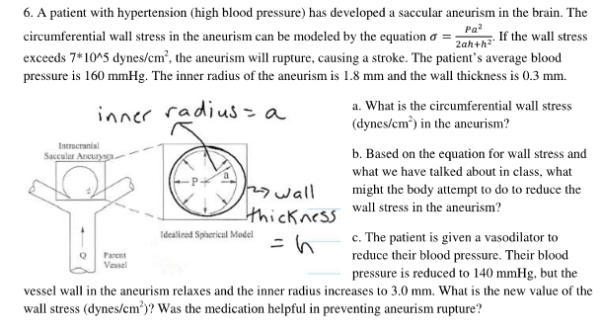A patient with hypertension has developed a saccular aneurism in the brain. The circumferential wall stress in the aneurism can be modeled by the equation sigma=pa^2/(2ah+h^2). If the wall stress exceeds 7*10^5 dynes/cm^2, the aneurism will rupture, causing a stroke. The patient's average blood pressure is 160 mmHg. The inner radius of the aneurism is 1.8 mm and the wall thickness is 0.3 mm. a) What is the cirumferential wall stress in the aneurism? b) Based on the equation for wall stress and what we have talked about in class, what might the body attempt to do to reduce the wall stress in the aneurism? c) The patient is given a vasodilator to reduce their blood pressure. Their blood pressure is reduced to 140 mmHg, but the vessel wall in the aneurism relaxes and the inner radius increases to 3.0 mm. What is the new value of the wall stress? Was the medication helpful in preventing aneurism rupture?
Highalphabet Home Page biomechanics biomechanics biomechaincs Page 1


A patient with hypertension has developed a saccular aneurism in the brain. The circumferential wall stress in the aneurism can be modeled by the equation sigma=pa^2/(2ah+h^2). If the wall stress exceeds 7*10^5 dynes/cm^2, the aneurism will rupture, causing a stroke. The patient's average blood pressure is 160 mmHg. The inner radius of the aneurism is 1.8 mm and the wall thickness is 0.3 mm. a) What is the cirumferential wall stress in the aneurism? b) Based on the equation for wall stress and what we have talked about in class, what might the body attempt to do to reduce the wall stress in the aneurism? c) The patient is given a vasodilator to reduce their blood pressure. Their blood pressure is reduced to 140 mmHg, but the vessel wall in the aneurism relaxes and the inner radius increases to 3.0 mm. What is the new value of the wall stress? Was the medication helpful in preventing aneurism rupture?
biomechanics page 1 biomechanics biomechanics biomechanics biomechanics biomechanics biomechanics biomechanics biomechanics page 2